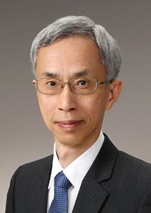2018 Recipients of C&C Prize
Group A

Professor Hidetoshi Nishimori
Professor, Tokyo Institute of Technology
Professor, Tohoku University
Citation
For contributions to quantum annealing and to research into random spin systems which underlie the fundamental mechanism enabling the development of quantum annealing machines
Achievements
Quantum computing is computing that exploits the quantum-mechanical phenomena such as superposition and entanglement. Two quantum-computing approaches are commonly known. One approach replaces classical logic gates with quantum gates that perform computations with quantum algorithms. The other approach, called quantum annealing (QA), solves the optimization problem by means of an Ising model or other statistical physics model. It is believed that superimposed quantum bits (qubits) can be used in quantum computing to perform massively parallel computations and high-speed processing of data. This ground-breaking computing capability is expected to enhance materials development and combinatorial optimization and, moreover, has potential for future artificial intelligence applications.
Prof. Hidetoshi Nishimori was the first to propose the quantum annealing computation model that operates under the natural laws of physics to enable high-speed resolution of hard and complex problems, such as combinatorial optimization. The basic theory of quantum annealing was developed in the field of statistical mechanics. The professor spent many years conducting research on the phenomena of random spin systems, which is a typical spatially non-uniform system that is regarded as a central problem in statistical mechanics. Through this research, he showed that there is a special area in a phase diagram, called the "Nishimori line", where an exact solution can be obtained. This discovery has been of monumental importance to statistical mechanics, and the professor’s remarkable contribution has been paramount to outcomes such as error correction code in information theory which leverages the properties of random spin systems and the Nishimori line. His findings also gave rise to a quantum annealing model that he jointly proposed with his student, Tadashi Kadowaki, in 1998. Through his research on mathematical models of magnetic bodies, in which he studied random interactions of particles with surrounding particles that had only two allowed orientations (up or down), he discovered that optimization problems consisting of systems that search for the lowest energy configuration is a standard format of combinatorial optimization.
Combinatorial optimization problems are parts of central to the field of information science, and since the 1980s, the statistical mechanical approach of simulated annealing (SA) has been regarded as a general purpose technique for solving them. SA uses thermal fluctuations to overcome high “energy” barriers to gradually lead the system to a low energy state that can be considered to be a solution to lowest-energy configuration problems. In QA proposed by Prof. Nishimori, rather than thermal fluctuations, quantum fluctuations are used to create a tunnel effect for faster convergence to the low energy state. This feature qualitatively indicates that QA offers a higher probability of finding the lowest-energy configuration; in other words, it finds an optimal solution faster than SA. Furthermore, on the basis of his knowledge of the ground state search problem of spin glasses, which is a typical problem encountered in research on random spin systems, the professor saw the potential in its application to the optimization problem. This prompted him to begin research on developing a solution based on quantum mechanics transitions, in other words, controlling quantum fluctuations. By gradually “annealing out” the effect of large quantum fluctuations on a frustrated system, the system converges to a stable statistical mechanics model that means the lowest-energy configuration. The resulting convergence gave rise to the basic concept underlying the quantum annealing computation model which corresponds to finding solutions for combinatorial optimization problems. Prof. Nishimori conducted exhaustive numerical experiments showing that QA techniques consistently outperform SA techniques in solving optimization problems. Moreover, the professor proved the convergence of QA; in other words, he provided a mathematical proof that the theory of convergence guarantees the discovery of the optimal solution. In this and other ways, he provided the mathematical foundation of QA. His findings have captured the attention of the world and have led to the development of the quantum annealing machine, the world’s first commercially available machine in 2011 (from D-Wave Systems, Inc.). The advent of this machine capable of solving specific problems extremely quickly triggered the development of new QA applications that go beyond finding solutions for combinatorial optimization problems. For instance, a range of innovative approaches leveraging QA’s remarkable capability of finding optimal solutions quickly are being developed in the field of artificial intelligence that brings together the methods of machine learning and deep learning which require vast amounts of data to be analyzed.
Prof. Nishimori’s quantum annealing, as a technique of quantum computing, has greatly enhanced the possibility of quick resolutions for complex combinatorial optimization problems that were difficult to solve with traditional methods. His innovative achievements, particularly, his fresh ideas from a field of theoretical research in random spin systems that is away from the information science field, are worthy of special mention. In recent years, Prof. Nishimori has participated in an IEEE Standards Association group to promote standardization of a quantum computer language. He is also involved in the Quantum Enhanced Optimization program, which was launched by the U.S. Government’s Intelligence Advanced Research Projects Activity (IARPA) to develop high-performance quantum annealers. Through his involvement in these projects, Prof. Nishimori continues to actively contribute to the development, expansion, and dissemination of quantum computing technology. Quantum annealers are interesting not only for their high-speed performance, but also for their ability of low power consumption to utilize superconducting qubits. In light of the high expectations set on quantum computing in promoting sustainability and solving the increasingly complex issues facing our information society, Prof. Nishimori’s remarkable achievements make him an excellent recipient of the C&C Prize.
